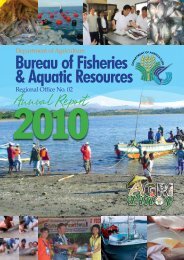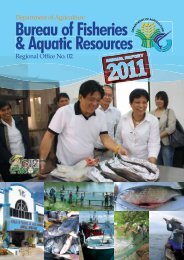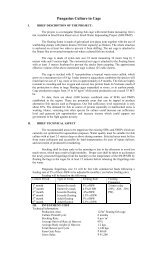Kalap Vol. 10, No. 01, January-June 2009 556kb - Bureau of ...
Kalap Vol. 10, No. 01, January-June 2009 556kb - Bureau of ...
Kalap Vol. 10, No. 01, January-June 2009 556kb - Bureau of ...
Create successful ePaper yourself
Turn your PDF publications into a flip-book with our unique Google optimized e-Paper software.
8<br />
Fish culture made possible in upland areas<br />
STA. FE, NUEVA VIZCAYA –<br />
Well known for its native handicrafts<br />
and upland veggies, this landlocked<br />
and mountainous province, may soon<br />
add fish to its array <strong>of</strong> indigenous<br />
products.<br />
According to Dr. Jovita Ayson,<br />
regional director <strong>of</strong> the fisheries<br />
bureau in Cagayan Valley, Nueva<br />
Vizcaya’s topography and climate –<br />
similar to the country’s Summer<br />
Capital, is not a hindrance for the<br />
large scale production <strong>of</strong> fish.<br />
Ayson made the comment during<br />
the launching <strong>of</strong> the fish condominium,<br />
a component <strong>of</strong> the ‘Fish for Upland<br />
Dwellers’ project here last March<br />
12. The project is part <strong>of</strong> the priority<br />
thrusts under BFAR Director<br />
Malcolm I. Sarmiento, Jr.<br />
“This demo project shall help us<br />
create income opportunities for fish<br />
farmers. It will also enable us to<br />
address nutritional needs <strong>of</strong> our<br />
constituents, as according to the<br />
DOH, upland dwellers are prone to<br />
fish protein deficiency,” RD Ayson<br />
said.<br />
This innovative fish culture<br />
project entails use <strong>of</strong> recycled metal<br />
drums opened and welded on end<br />
to form a chamber where fish can<br />
be cultured.<br />
One module consists <strong>of</strong> 9 such<br />
chambers laid out in horizontal<br />
manner and stacked in 3 tiers with<br />
angle bars as frame.<br />
According to Dominador<br />
Abalos, the project, stocked with<br />
3,000 pieces African hito fingerlings,<br />
can produce approximately 1,000<br />
kilos <strong>of</strong> fish after 6 months culture<br />
period. Projected net income is<br />
50,000 pesos with farm gate price<br />
<strong>of</strong> 1<strong>10</strong> pesos. Feed cost is 40,000<br />
pesos while depreciation cost <strong>of</strong> the<br />
structure 9,200 pesos per year.<br />
The number <strong>of</strong> fish stocked per<br />
KALAP <strong>January</strong> - <strong>June</strong> <strong>2009</strong><br />
chamber ranges from 300 to 400<br />
pieces. This is to enable the<br />
implementors to determine the<br />
optimal stocking density <strong>of</strong> fish in<br />
such culture system.<br />
A salient feature <strong>of</strong> the project is<br />
its use <strong>of</strong> the free-flowing water from<br />
mountain streams. Outlets <strong>of</strong> this<br />
free-flowing water can be seen on<br />
the roadside when one traverses the<br />
Maharlika highway here.<br />
“Unlike other fish culture<br />
technologies having high stocking<br />
density and limited space, our<br />
project does not use energyconsuming<br />
aerators and water pumps<br />
to maintain water quality, thanks to<br />
the year-round water from the<br />
mountains,” the project leader said.<br />
“Nueva Vizcaya’s mountainous<br />
feature makes it very difficult and<br />
expensive to construct fishponds,<br />
particularly in the highlands. This<br />
technology allows us to culture fish<br />
in constrained and marginal areas.”<br />
Abalos said that potential<br />
production from the project is almost<br />
equal to a 1,000 square meter<br />
fishpond. He added that the<br />
technology can also be applied in<br />
urban areas.<br />
Abalos added that cost <strong>of</strong> the<br />
structure can be eliminated by<br />
arranging the drums in a cascading<br />
manner such that it rest on and<br />
follows the sloping contour <strong>of</strong> the<br />
land.<br />
Sta. Fe Mayor Florante Gerdan<br />
expressed his support and<br />
appreciation <strong>of</strong> the project during the<br />
launching activity which was held in<br />
line with the celebration <strong>of</strong> the 14 th<br />
Kalanguya Festival and Sta. Fe town<br />
fiesta.<br />
To maximize exposure <strong>of</strong> the<br />
technology, BFAR RO2 has<br />
allocated one similar module for<br />
Diadi town this province.<br />
Alleged Taiwanese<br />
poachers apprehended<br />
anew<br />
(from page 1)<br />
Earlier, another Taiwanese fishing<br />
vessel Tz Fu Tien BJ 4771 was<br />
apprehended by elements <strong>of</strong> the<br />
Philippine Coast Guard and <strong>Bureau</strong><br />
<strong>of</strong> Fisheries and Aquatic Resources<br />
aboard MCS 30<strong>01</strong>, within municipal<br />
waters east <strong>of</strong> Sta. Ana.<br />
Crew <strong>of</strong> both vessels are now<br />
facing criminal complaint before the<br />
Assistant Provincial Prosecutors<br />
Office in Aparri, Cagayan for illegal<br />
fishing and poaching in violation to<br />
Sections 86 and 87 <strong>of</strong> the Philippine<br />
Fisheries Code <strong>of</strong> 1998, Republic<br />
Act 8550.<br />
Tz Fu Tien is manned by<br />
Taiwanese nationals named Horng<br />
Shenq Fwu (boat captain), Lii Jyi<br />
Long and their Indonesian crew<br />
identified as Susanto, Saidin,<br />
Riyanto, Sutikno, Iswanto,<br />
Mohamad Hidayat, Ari Hermanto,<br />
Tahyanur, Hasanudin and Hadi<br />
Warno.<br />
The vessels are currently docked<br />
at Port Irene in Sta. Ana where its<br />
crew are detained under custody <strong>of</strong><br />
BFAR and PCG while awaiting<br />
further development <strong>of</strong> their case.<br />
Assorted fishes mostly yellow fin<br />
tuna, sharks (de-finned) and dolphin<br />
fish (dorado) have been found in both<br />
vessels.<br />
“Just like this latest vessel, Tz Fu<br />
Tien was also caught inflagrante<br />
delicto or on-the-act,” BFAR<br />
Regional Director in Cagayan Valley<br />
Jovita Ayson said, adding that the<br />
fisheries agency will also file separate<br />
administrative charges against both<br />
vessels. .<br />
Three BFAR patrol boats are<br />
currently in region 02 to conduct<br />
anti-poaching operations upon<br />
orders from BFAR National Director<br />
Malcolm Sarmiento, Jr.






